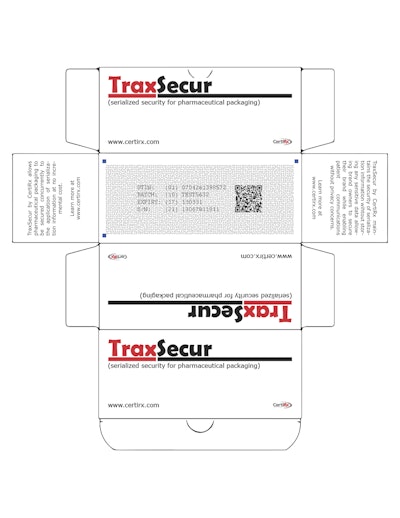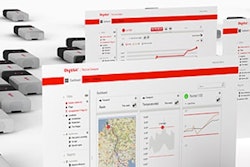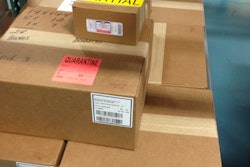When the U.S. House of Representatives in late September passed H.R. 3204 it offered hope that the U.S. Senate would promptly approve it and send it on for President Obama’s signature. And then came the government shutdown.
Should the bicameral bill be signed into law it could help clarify the U.S. position on pharmaceutical serialization and e-pedigree. The law would preempt California e-pedigree, providing a federal-based system that would give manufacturers and packagers more time to comply compared with the initial California e-pedigree phase-in dates.
Clarity also arrived for the medical device community, when the U.S. Food and Drug Administration on Sept. 24 announced that it had issued a final rule on Unique Device Identification that provides a pathway for device makers.
According to Dirk Rodgers, author of RxTrace and Healthcare Packaging Contributing Editor, progress was made during the August recess when managers from separate House and Senate bills and their staffs were able to create a compromise bill. (See the draft of the bill here.)
“They were pretty far apart considering the House bill had completely different requirements for track and trace and the Senate bill included the compounding language. Those two bills were so far apart that they had to go some way to resolve the differences,” says Rodgers.
Presidential approval would mean that the new law would become effective immediately, with serialization requirements taking place four years later. Other provisions would occur at other effective dates, based on when the President signs. The bill’s passage would preempt pending California e-pedigree legislation and give the packaging community between two to three years of additional time to comply compared to the initial Jan. 1, 2015 California e-pedigree phase-in date.
“The California law says that if the federal government passes a bill that has anything to do with track and trace, e-pedigree or serialization, then their bill would immediately become non-functional,” says Rodgers.
“California actually is glad to see the federal government take action on this to take it off of their plate, not just because they will no longer have to administer it, but because they truly believe that’s the right way for this to happen. They introduced their legislation in early 2000 because they felt that the federal government was not acting quickly enough. But they agree that the right way to regulate the national supply chain is through the federal regulation,” he adds. (Rodgers offers definitions for serialization, unique device identification, e-pedigree, track and trace, and brand authentication/brand protection at the end of this article.)
Healthcare Distribution Management Assn. (HDMA) President and CEO John M. Gray released the following statement on the House’s passage of H.R. 3204:“Now that the House of Representatives has passed legislation to strengthen the security of the pharmaceutical supply chain, only the Senate’s imminent vote stands in the way of establishing a federal uniform traceability framework for prescription medicines. For nearly a decade, HDMA has worked to replace the 50-state patchwork of rules and regulations with a federal solution that ensures regulatory clarity and consistency, helps prevent counterfeits, discourages gray market activities, and enhances the safety and security of the pharmaceutical supply chain for all Americans.”
Chris Siegele, Serialization Specialist for Omega Design Corp., a global provider of packaging products for the pharmaceutical, nutraceutical, and consumer healthcare industries, said, “While the U.S. Congress considers a new bill that would delay a full domestic track-and-trace system, regulations around the globe to improve supply chain security are going live. Due to both momentum in the U.S. and regulations globally, manufacturers continue with plans to serialize product at the unit level. And to not be left behind by competitors, forward-thinking pharmaceutical companies are moving ahead with their own serialization initiatives to gain product visibility and data for improving distribution.”
UPS, which partners with healthcare companies to choreograph logistics from the factory floor to the patient, offers the following perspective from Chip Meyers, VP of Corporate Public Affairs:
"When planning for serialization and e-pedigree, companies must consider technology when preparing for serialization—not only does their chosen system need to integrate well with other systems, in the event that there are a variety of standards and system requirements, but they also need to enhance their technology and regulatory expertise. This can be achieved by supplementing current expertise, or by engaging with an outside partner to ensure your company is ahead of the curve and appropriately prepared. Engaging a 3PL could be of particular benefit, as some third-party logistics providers have global regulatory expertise as well as advanced technology systems that can integrate with existing systems to ensure end-to-end supply chain visibility and enable intervention as needed.
“Another very critical consideration for the serialization deadline is the timeframe. While serialization will ultimately benefit patients and consumers, along with pharmaceutical companies, it can seem overwhelming at this stage of the game, particularly as it represents a significant investment in planning, expertise, and resources. When your company is ready to test its systems, it's important to pilot the program on one product line or segment of the business, this way it can be refined and improved prior to rolling it out to all of your products.”
Delivering a return on investment
Devendra Mishra is the Executive Director of Bio Supply Management Alliance, which addresses operations and supply chain management issues in biotech, biopharma, and biomedical device industries. She notes, “Companies that focus purely on achieving compliance will miss the opportunity to use regulation as a business driver. Although simple e-pedigree systems are an important first step, significant improvement in the overall supply chain of the biotech industry and public safety would result from a more standardized and automated approach. Such systems with serialization, packaging with printing and vision, data interchanges between trading partners, and incorporation of track-and-trace technology, have enormous ROI.”
BSMA cited recent research indicating that the ability to track and serialize unit-level saleable packages (e.g. bottle of 25 pills), not just cases or pallets, can create business value. Knowing exactly where their products are purchased can do the following:
1. Minimize cost of chargebacks through 100% accurate adjudication. Chargebacks account for 2% to 15% of gross revenue for a pharmaceutical manufacturer.
2. Minimize risk by increasing accuracy in Medicare/Medicaid pricing calculations by fully knowing all fees, rebates, and chargebacks that should be applied to a specific unit sale. Over $4B in fines have been handed down for improperly calculating Medicare/Medicaid pricing.
3. Limit liability of having to recall entire lots of product because a (non-serialized) shipment was stolen.
4. Achieve visibility for manufacturers in the labyrinth that is the wholesale distribution network to more accurately forecast demand and measure sales and marketing.”
The alliance, in advance of its Oct. 8 conference, also noted, “The production of substandard and fake drugs is a vast and under-reported problem, particularly affecting poorer countries. The FDA estimates that fake drugs comprise approximately 10 percent of the global medicine market. Compounding the problem is the theft and illegal diversion of medical products in the supply chain. Considering the consequent loss of life and the economic incentive for these illegal activities, the justification for pedigree and serialization is compelling but it requires the collaboration of all stakeholders of the biopharma industry.”
Cloud-based data storage
Storing e-pedigree, track-and-trace, and related data from packaging lines, companies, and supply chain distribution is an essential piece of the serialization puzzle.
One supplier in this area is Kezzler, a provider of consumer verification and track-and-trace enterprise software delivered through the cloud.
“The key issue that is most important in serialization in volume is the data management aspect,” says R. Tod Urquhart, Kezzler AS Sales Director. “What people do not realize is that a traditional relational database has technical limitations in volume and its performance falls off very quickly once you reach around 50 million serial numbers. The key point here is that this is the single-biggest challenge for serialization, and it is never discussed. We know from several large pharma companies that they are having data management issues at the 100 million to 200 million serial number mark. The only way that this can be solved is by increasingly large investments in equipment. This leads to a database index running across many servers with increased complexity and thus support required. The downside is that there is no end point.”
Global perspectives
With customers around the world, Kezzler offers a perspective on serialization efforts in several countries:
• India has played a leading role in consumer empowerment of medicines through serialization and POS verification. Roche was a pioneer in this regard and started to protect their anti-cancer line of drugs (Avastin, Herceptin, Neulastim, MabThera, etc.) through us more than five years ago. What is notable is that within a very short time, they completely eliminated the presence of counterfeit variants of their drugs from the Indian market through serialization and an aggressive outreach campaign to doctors and patients. Although the counterfeiting problem was eliminated in India, it started popping up elsewhere where the serialization program had not yet begun. An excellent case study in this regard is Avastin.
• The East African market has embraced serialization and there are impressive developments. The pace is slower than we had hoped but clearly there has been acceptance across different vertical [markets], including pharma. We have worked with a local company, Alphadot Security, which has played a leading role in serializing products in Kenya, Tanzania, and Uganda.
• In the Asia Pacific region, Pfizer has set up a serialization program for Viagra, Lipitor, and Norvasc. The goal is to empower consumers.”
Technological development
CertiRx is developing and commercializing proprietary platform technology for authentication and verification of high-value products and important digital or physical document renderings. It is seeking partners among both pharmaceutical companies and suppliers for its products, which include the following:
• CertiTag™, a method for creating product authentication codes that may be implemented to ensure the authenticity of formulated products, like pharmaceutical solid oral dosage forms, and drug delivery devices such as patches, liquid formulations, raw materials, and outsourced product components.
•AuthentiForm™, developed for securing both physical and electronic document renderings.
• TraxSecur™, which delivers Serialized Security™ as track-and-trace information is applied to packages, and is designed to do so with “no appreciable incremental cost,” says Thomas J. Mercolino, PhD, and President and CEO. Mercolino added, “Our applications for the print- and image-based authentication technologies bridge the gap between information systems and security systems.”
Mercolino spoke with Healthcare Packaging at Pack Expo Las Vegas in late September, touring the show with Jim Umbdenstock of Griffin-Rutgers, a supplier of printing, marking, barcoding, labeling, and print-and-apply systems and supporter of CertiRx. (Watch a video on TraxSecur here.)
According to CertiRx, each of the TraxSecur and AuthentiForm products is based upon a patented method for creating printed authentication codes in a simple but powerful ‘combinatoria’ approach.’ Codes based on this method are designed to offer users the following benefits:
• Flexible implementation on product packaging, articles of manufacture with a printable surface, or important documents.
• Ability to detect fraudulent changes to human-readable content (e.g., expiration date and track-and-trace character string) without storing any sensitive information.
• Codes are generally more difficult to “break” than alternative approaches.
• Resistance to intentional or inadvertent alteration or removal.
• The platform minimizes implementation cost as typical applications require no new hardware on either the printing side or the reading/verification side and minimizes negative impact on cost of goods.
Talking terminology
Dirk Rodgers offers insights into the terms serialization, UDI, e-pedigree, track and trace, and brand authentication.
• Serialization: The application of a unique serial number at a given level of production. Lately regulators have ceased on serialization at the unit package level but most people also consider lot numbers to be a form of serialization. Serial numbers applied to drug packages at the unit level can take the form of barcodes or RFID, depending on the regulation being met and/or the preferences of the trading partners involved.
• Unique Device Identification (UDI): The name of a regulation that the U.S. FDA just published intended to standardize device identifiers that are used in the U.S. Drugs have had a standard identifier—the National Drug Code, or NDC—since the early 1970’s but device manufacturers were not restricted so almost every manufacturer created its own way of identifying its products. This causes confusion in hospitals and other medical settings and in reimbursement. Now, over the next few years, manufacturers will need to create identifiers that conform to the UDI regulations, which should result in improved accuracy and efficiency in the supply chain and for patients.
UDI requires the product identifier to be complimented with relevant production identifiers like lot/batch, version, and in some cases serial number. A serial number is only required if the FDA had previously required a device to carry a serial number. The
UDI regulation also requires all devices to be listed in the FDA’s new Global Unique Device Identifier Database (GUDID). The regulation will become effective for different classes of devices over the next few years.
• E-pedigree: A way of documenting the supply chain transactions of a specific unit of product—drugs in the case of the various U.S. state and federal pedigree laws. In some cases it can be paper documentation, but the California pedigree law requires the documentation to be created and passed from seller to buyer electronically, in parallel with the physical movement of the drugs. Under that law, an e-pedigree documents the chain of ownership transactions from manufacturer to dispenser. Pedigrees protect the evidence of this chain of ownership so that criminals cannot insert illegitimate product in the middle of the supply chain.
• Track and trace: A way of knowing where a product is right now (track) and where it has been in the past (trace). The track part is usually from the perspective of the manufacturer being able to find out where the products they manufactured are right now, and the trace part is usually from the perspective of the current owner of the product and its ability to find out the path the product took from the manufacturer to their possession. You can see that the trace part is really the same as an e-pedigree, although “track and trace” is generally considered to be less rigid than e-pedigree.
• Brand authentication, or brand protection: The application of one or more product forensic technologies intended to allow a manufacturer or other entity to later determine if the product package or the product itself is one that they manufactured. Counterfeiters have become so skilled at reproducing the visual appearance of products and their packaging that manufacturers have sometimes found it necessary to add these technologies to make it easier to determine real from fake. The number and type of these technologies is quite large. Recently a number of vendors have begun marketing brand protection technologies that combine serialization with a product forensic technology, but these single elements serve dual purposes rather than merging the purposes. That is, they enable compliance with existing serialization laws but also provide an additional brand protection element in addition.


























